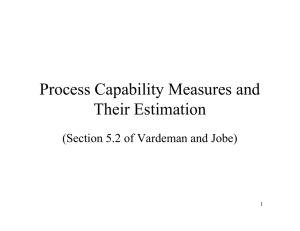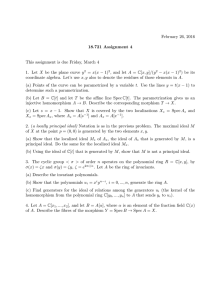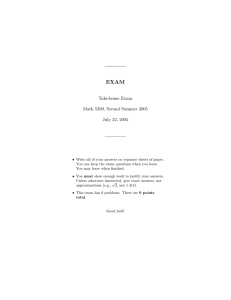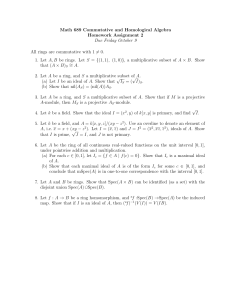Document 13548599
advertisement
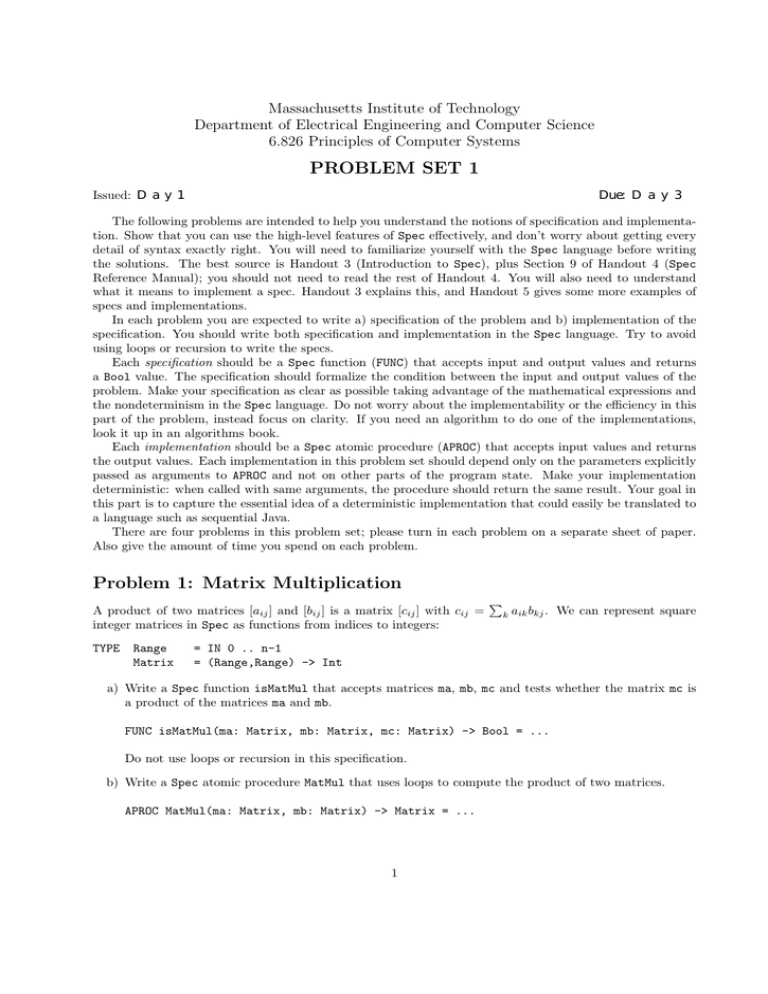
Massachusetts Institute of Technology
Department of Electrical Engineering and Computer Science
6.826 Principles of Computer Systems
PROBLEM SET 1
Issued: D a y 1
Due: D a y 3
The following problems are intended to help you understand the notions of specification and implementa­
tion. Show that you can use the high-level features of Spec effectively, and don’t worry about getting every
detail of syntax exactly right. You will need to familiarize yourself with the Spec language before writing
the solutions. The best source is Handout 3 (Introduction to Spec), plus Section 9 of Handout 4 (Spec
Reference Manual); you should not need to read the rest of Handout 4. You will also need to understand
what it means to implement a spec. Handout 3 explains this, and Handout 5 gives some more examples of
specs and implementations.
In each problem you are expected to write a) specification of the problem and b) implementation of the
specification. You should write both specification and implementation in the Spec language. Try to avoid
using loops or recursion to write the specs.
Each specification should be a Spec function (FUNC) that accepts input and output values and returns
a Bool value. The specification should formalize the condition between the input and output values of the
problem. Make your specification as clear as possible taking advantage of the mathematical expressions and
the nondeterminism in the Spec language. Do not worry about the implementability or the efficiency in this
part of the problem, instead focus on clarity. If you need an algorithm to do one of the implementations,
look it up in an algorithms book.
Each implementation should be a Spec atomic procedure (APROC) that accepts input values and returns
the output values. Each implementation in this problem set should depend only on the parameters explicitly
passed as arguments to APROC and not on other parts of the program state. Make your implementation
deterministic: when called with same arguments, the procedure should return the same result. Your goal in
this part is to capture the essential idea of a deterministic implementation that could easily be translated to
a language such as sequential Java.
There are four problems in this problem set; please turn in each problem on a separate sheet of paper.
Also give the amount of time you spend on each problem.
Problem 1: Matrix Multiplication
A product of two matrices [aij ] and [bij ] is a matrix [cij ] with cij =
integer matrices in Spec as functions from indices to integers:
TYPE Range
Matrix
�
k
aik bkj . We can represent square
= IN 0 .. n-1
= (Range,Range) -> Int
a) Write a Spec function isMatMul that accepts matrices ma, mb, mc and tests whether the matrix mc is
a product of the matrices ma and mb.
FUNC isMatMul(ma: Matrix, mb: Matrix, mc: Matrix) -> Bool = ...
Do not use loops or recursion in this specification.
b) Write a Spec atomic procedure MatMul that uses loops to compute the product of two matrices.
APROC MatMul(ma: Matrix, mb: Matrix) -> Matrix = ...
1
Problem 2: Distribution of Prime Numbers
Let x and y be positive integers.
We say that y is a divisor of x if the division of x by y yields no remainder.
We say that x is a prime number if x > 1 and the set of the divisors of x is {1, x}.
Theorem [Chebyshev] For every integer n > 1 there exists a prime number p such that n < p < 2n.
a) Write a Spec function isPrimeBetween that checks if p is a prime number between n and 2n.
FUNC isPrimeBetween(p: Int, n: Int) -> Bool = ...
b) Write a Spec atomic procedure primeBetween that, given n, finds a prime p such that n < p < 2n.
APROC primeBetween(n: Int) -> Int = ...
c) Show an example of positive integers n and p such that isPrimeBetween(p,n) is true, but your
implementation in the b) part never returns p when called with primeBetween(n).
Problem 3. Shortest Path
A directed graph is a binary relation on some set. See Section 9 of Handout 4 for the definitions of some
graph operations. Let graph nodes be defined as
TYPE Node = IN 1 .. n
a) Write a Spec function isShortestPath that tests whether path is the shortest path from n1 to n2 in
the graph g.
FUNC isShortestPath(g: Graph[Node].G,
n1: Node, n2: Node,
path: SEQ Node) -> Bool = ...
b) Write a Spec procedure shortestPath that given a graph g and two nodes n1 and n2 finds a shortest
path from node n1 to node n2. Make sure that your solution implements the specification in part a),
is deterministic, and has polynomial time complexity.
APROC shortestPath(g: Graph[Node].G,
n1: Node, n2: Node) -> SEQ Node = ...
c) Show an example of a graph g, nodes n1 and n2 and path path such that the value of the expression
isShortestPath(g,n1,n2,path) is true, but your implementation in part b) never returns path as a
result if invoked with the procedure call shortestPath(g,n1,n2).
2

